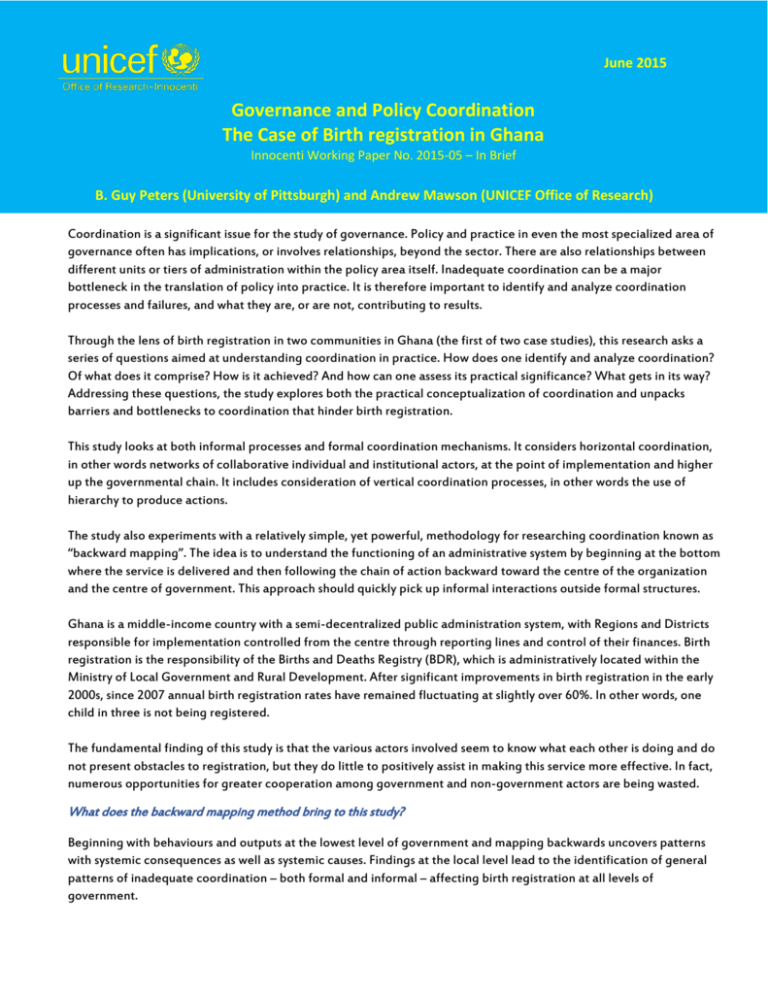Kb 253198 - UNICEF - Office of Research
advertisement

June 2015 Governance and Policy Coordination The Case of Birth registration in Ghana Innocenti Working Paper No. 2015-05 – In Brief B. Guy Peters (University of Pittsburgh) and Andrew Mawson (UNICEF Office of Research) B. Guy Peters (University of Pittsburgh) and Andrew Mawson (UNICEF Office of Research) June 2015 Coordination is a significant issue for the study of governance. Policy and practice in even the most specialized area of governance often has implications, or involves relationships, beyond the sector. There are also relationships between different units or tiers of administration within the policy area itself. Inadequate coordination can be a major bottleneck in the translation of policy into practice. It is therefore important to identify and analyze coordination processes and failures, and what they are, or are not, contributing to results. Through the lens of birth registration in two communities in Ghana (the first of two case studies), this research asks a series of questions aimed at understanding coordination in practice. How does one identify and analyze coordination? Of what does it comprise? How is it achieved? And how can one assess its practical significance? What gets in its way? Addressing these questions, the study explores both the practical conceptualization of coordination and unpacks barriers and bottlenecks to coordination that hinder birth registration. This study looks at both informal processes and formal coordination mechanisms. It considers horizontal coordination, in other words networks of collaborative individual and institutional actors, at the point of implementation and higher up the governmental chain. It includes consideration of vertical coordination processes, in other words the use of hierarchy to produce actions. The study also experiments with a relatively simple, yet powerful, methodology for researching coordination known as “backward mapping”. The idea is to understand the functioning of an administrative system by beginning at the bottom where the service is delivered and then following the chain of action backward toward the centre of the organization and the centre of government. This approach should quickly pick up informal interactions outside formal structures. Ghana is a middle-income country with a semi-decentralized public administration system, with Regions and Districts responsible for implementation controlled from the centre through reporting lines and control of their finances. Birth registration is the responsibility of the Births and Deaths Registry (BDR), which is administratively located within the Ministry of Local Government and Rural Development. After significant improvements in birth registration in the early 2000s, since 2007 annual birth registration rates have remained fluctuating at slightly over 60%. In other words, one child in three is not being registered. The fundamental finding of this study is that the various actors involved seem to know what each other is doing and do not present obstacles to registration, but they do little to positively assist in making this service more effective. In fact, numerous opportunities for greater cooperation among government and non-government actors are being wasted. What does the backward mapping method bring to this study? Beginning with behaviours and outputs at the lowest level of government and mapping backwards uncovers patterns with systemic consequences as well as systemic causes. Findings at the local level lead to the identification of general patterns of inadequate coordination – both formal and informal – affecting birth registration at all levels of government. What does the focus on birth registration reveal about coordination? One of the more important findings is that even at the local level, coordination requires an investment of time and energy, and perhaps also more tangible resources. The study hypothesized that enhancing coordination with other actors may be an especially attractive strategy for poorly resourced services. Our findings suggest that after a certain point inadequate resourcing is a major barrier to effective coordination. This leads on to the importance of leadership. The absence of effective leadership within the organization at multiple levels is apparent particularly in attempts to produce linkages with other organizations. No matter how valuable coordination may be, it does not occur on its own but requires active involvement of members of an organization, especially those in leadership positions. An important part of this is addressing and aligning formal and informal incentives to coordinate, both internally within an organization such as the BDR, and beyond it – in this case other actors in the public sector and, at the community level, volunteers and other parts of civil society. Normative assertions of the value or importance of the service are insufficient. Much of the study of coordination emphasizes hierarchy and the power of actors at the centre of government. The emphasis on scrutiny of coordination at the lowest level of government in this study demonstrates that developing functioning networks of actors at the local level may be able to address problems created in the centre of government. Having said this, weaknesses in coordination at higher levels impede the solution of operational difficulties at lower levels. Interactions do not necessarily lead to effective coordination, if there is absence of leadership in networks and the absence of resources to motivate actions. A key message for development practitioners is that analysis of formal coordination mechanisms involved in the implementation of programmes is only part of the story. Informal processes at the point of implementation are not only revealing but fundamentally important for understanding how a system works and how it can be strengthened or reformed. What does the study of coordination reveal about birth registration? While the BDR is formally responsible for registration it cannot fulfil its mandate without coordinating with others. This is not just a description of the status quo, but a systemic issue facing the Registry in the quest for sufficient resources and opportunities to reach out to the public. The clear outputs inherent in birth registration, combined with the necessary interaction involved at all levels, make birth registration rates a powerful governance indicator. In Ghana, the BDR is insufficiently resourced, but extra resources allocated to it will not solve the challenges it faces to reach 100% birth registration unless these are linked to improved oversight and formal coordination with other major actual or potential players at higher levels (for example, the Ghana Health Service, the Ghana Statistical Services, and the Ghana Education Service), lending formal support to enhanced interaction at the local level. The study identifies a general lack of coordination and collaboration at all levels of government concerning birth registration. The BDR is not well connected to other organizations such as the Ministry of Health and the Ministry of Education which could be important partners in performing its tasks. It does not appear to have any appreciable influence with the Ministry of Finance that could improve its funding. It seems that possible partners such as the Ghana Statistical Service and the economic planners would be willing to collaborate but are faced with an apparent lack of interest on the part of the BDR. Considering the nature of informal as well as formal coordination reveals that action is largely initiated by actors other than the Registry itself. Local registry officials were identified as largely passive; this reinforces the importance in Ghana of civil society actors – Registry volunteers – in the governance of birth registration, notwithstanding a challenge of petty corruption involved in some of this. At the local level, community health nurses and other health officials are also important allies, but coordination between them and Registry staff is locally negotiated and ad hoc. A more systematic pattern of cooperation would help produce more effective registration across the country.







